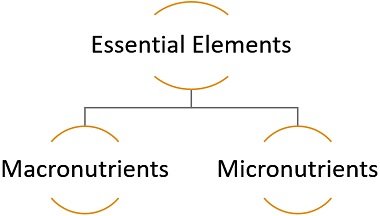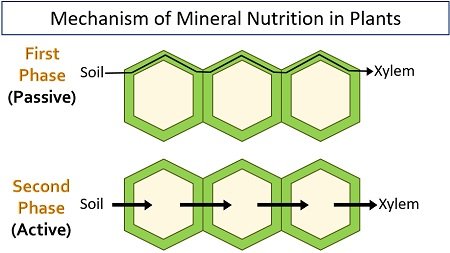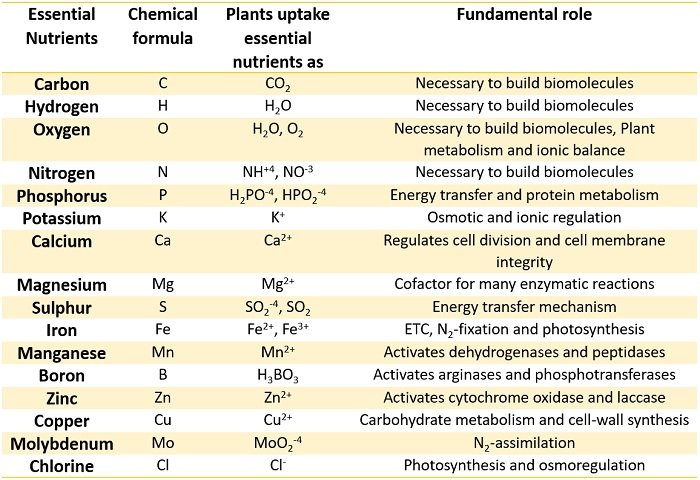Mineral nutrition is important for plant sustainable growth and yield. The root system of plant uptakes minerals in the form of ions from the soil, while the minerals naturally remain in the soil as salts. Plants obtain basic nutrients such as C, N, H and O from the sources like air and water. Thus, roots facilitate the uptake of these mineral ions from the soil to the conducting tissues (xylem and phloem).
In this lesson, we will discuss the definition, types, criteria for establishing the essentiality and hydroponic method to identify essential and non-essential minerals for plant growth. This context also elucidates the role of the essential elements, their deficiency and toxicity symptoms, as well as their mechanism of absorption by the plants.
Content: Mineral Nutrition in Plants
- Types
- Criteria for Essentiality
- Hydroponics
- Role
- Mineral Deficiency in Plants
- Important Terms
- Mechanism
Definition of Mineral Nutrition in Plants
Mineral nutrition in plants is a phenomenon in which the plant’s roots uptake different essential minerals or nutrient elements for cell growth, reproduction and metabolism. Nearly 112 essential elements are found in the soil, among which the plant’s roots absorb only 60 nutrient elements. Not all 60 minerals are essential for plant growth. According to the research, there are only 16 to 20 mineral elements considered essential for plants. Plants primarily obtain the essential minerals from the soil, while some elements get it through the atmosphere.
Types of Essential Nutrients
Based on the quantitative requirement by the plants, the essential elements are generally categorized into the following two types:

- Macronutrients: These include nine elements like C, H, O, N, P, S, K, Ca and Mg that are necessary for plant survival. Macronutrients are also called major nutrients, required in higher amounts (about 10 mg/g of dry matter).
- Micronutrients: These include seven elements like Fe, Mn, Cu, Zn, Mo, B and Cl that is also crucial for plant growth. Micronutrients are called minor nutrients or trace elements, required in low amount (0.1 mg/g of dry matter).
Besides macro and micronutrients, elements like Na, Co, Va, Ni and Si are also important for some plants. We can obtain all the mineral elements through the plant’s ash except for C, H, O, N and S that go up in smoke.
Criteria for Essentiality
Arnon and Stout, in 1939, pioneered this approach to make us understand the reasons for which the essential nutrients are considered “Essential”. Let us discuss a few of the factors to understand the criteria of essentiality.
- Essential elements are the components of biomolecules like proteins, carbohydrates, lipids and nucleic acids necessary for plant cell growth and reproduction.
- All the 16 essential minerals are specifically required for plant growth, which means the deficiency of one mineral element cannot be substituted with the other mineral sources.
- Some of the essential elements are the components activating different enzymes and thereby also involved in cell metabolism.
- Lack of any essential nutrients may lead to mineral deficiency in plants like Mg2+ deficiency causes chlorosis or leaf-yellowing.
Hydroponics
Water culture or soil-less culture are the alternative terms of the hydroponics technique. Hydroponics is a technique of growing plants in the aqueous medium supplemented with all the essential nutrients in the desired amount that is necessary for plant growth.
Julius Von Sachs in 1980 pioneered the hydroponics method technique to find out the essentiality and deficiency symptoms of the nutrient elements. A plant’s root system is exposed to water in a hydroponics system, and a shoot system is exposed to air and light.
Thus, hydroponics is a method of culturing plants in water, without soil. For plant growth, known nutrients are supplemented in water but in a definite proportion. There is an aerating tube in the hydroponics system for the aeration.

For plant growth, vigorous air-bubbling is practised daily to provide continuous oxygen supply to the plant’s root system. Also, a funnel is equipped in the hydroponics system through which the water and all the essential nutrients are transferred into the growth culture.
Objectives
Hydroponics technique focuses on the following objectives:
- It determines the essentiality of the minerals for plant growth.
- It also determines the non-essential elements.
- The hydroponics technique helps us to know the quantity of each mineral prerequisite for plant growth.
- Seedless cucumbers, tomatoes etc., are the plants successfully grown in the water culture.
- Through hydroponics theory, we can determine the essentiality of the nutrients by performing several experiments.
Experiment-1: You need to culture a plant in the aqueous medium supplemented with all the essential nutrients except for the one to know the importance and the deficiency symptoms of the lacking nutrient in the water culture.
Similarly, the experiments can be practised for many other mineral elements by following the same protocol. We can observe the results by comparing the plant’s growth in a limited nutrient culture with the plants growing in the water culture supplemented with all the essential minerals.
Role of Mineral Nutrients
Mineral Deficiency in Plants
The number of mineral ions uptaken by the plants should be in appropriate concentration. Any increase or decrease in the mineral ions concentration may cause mineral toxicity and mineral deficiency, respectively.
Mineral deficiency symptoms are characterized by the following factors:
- Chlorosis, chlorophyll loss or leaf-yellowing occurs due to the lack of K, Mg, N, and S.
- Necrosis or cell death results due to the deficiency of K, Ca, and Mg etc.
- Inhibition of cell-division results due to the lack of N, K, B, and Mo.
- Retarded growth is due to the deficiency of elements such as N, P, and Zn etc.
- The deficiency of K and P causes leaf-foliage.
- Deficiency of N, S, and Mo etc., results in delayed flowering.
Mineral toxicity symptoms are characterized by the following factors:
- Brown spots appear due to Mn (Manganese) toxicity. Leaves are also surrounded by chlorotic veins. Mn-toxicity inhibits Ca translocation as well as competes with Fe and Mg for binding with enzymes. Thus, Mn toxicity causes Fe, Ca and Mg deficiency.
Important Terms
To describe the levels of nutrients in plants, we must go through the following terms:
- Deficient: It is defined as the proportion of any nutrient mineral, which is low enough to cause deficiency symptoms in plants.
- Critical range: It is the proportion of mineral nutrients below which plant yield is reduced.
- Sufficient: It is the concentration range of essential nutrients, which only increases nutrient consumption. Luxury consumption is another term used to denote sufficient mineral consumption. It does not increase the plant yield.
- Excessive or toxic: It is the concentration range of essential nutrients, which is large enough to cause mineral toxicity on the plants. It causes ion imbalance, thereby retards plant growth.
Mechanism of Mineral Nutrition in Plants
The plants absorb minerals or nutrient ions through their roots from the soil. A stele is a structure within the root system, which allows the passage of mineral ions to the conducting tissues. Water potential decides the path of nutrient absorption. The mechanism of mineral nutrition in plants can be summarized into two phases.

During the first phase, the mineral salts or ions in soil move into the plant cells’ free space or apoplast. Here, the ions’ movement does not need energy expenditure, as they move from the region of high to low concentration.
Thus, the first phase of mineral nutrition involves the passive transport of the ions. It is important to keep in mind that the movement in the first phase is rapid and mediated via ion-channels and transmembrane proteins.
In the second phase, the mineral salts or ions move into the plant cells’ inner space or symplast. Here, the ions’ movement needs expenditure of energy as they move from the region of low to a high concentration. Thus, the second phase of mineral nutrition involves the active transport of ions.
We should remember that the movement of ions in the second phase are quite slow and mediated via plasmodesmata. The ions from the apoplast and symplast enter the xylem cells, which cause conduction of water upwards or to the plants shoot system.

Thank you for helping me find my research on mineral nutrients.